From April 2019, The Indian government made ‘Airbags’ a compulsory fitment for all cars that are to be sold in the country thereon. This ruling came into existence in the wake of safety being considered as the utmost priority as far as automobiles and motoring are concerned.
It is in India where such strict norms concerned about the safety of the passengers on board an automobile came into existence in the yesteryears. In America and European countries, airbags began to appear in almost every new car as standard in the ‘90s.
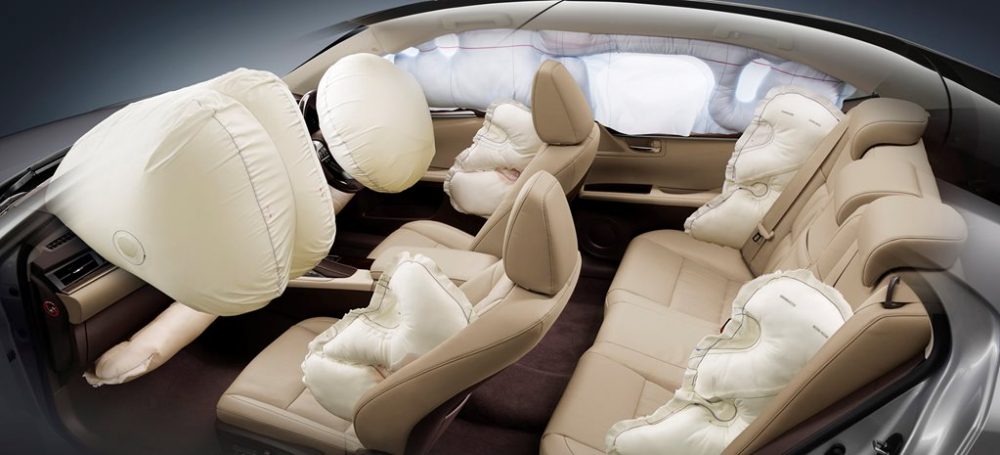
However, just like in India, countries like America took a while to comprehend the importance of airbags as life-saving equipment in cars. It took thousands of car accident fatalities, decades of persistent struggle with auto giants, and years of development and advancements in car safety technology for the modern-day car airbag to come into existence. Hence, today we decided to take a look at the journey of one ‘godsend’ of safety equipment for automobiles, Airbags!
Read More: 10 Must-Have Safety Features on Indian Cars in 2020
What is an Airbag?
An airbag is a vehicle occupant-restraint system consisting of an inflatable bag which interferes between the passengers and the car’s dashboard during a collision, preventing passengers from serious injuries.
The mechanism of the airbag works by the chemical reactions and an array of sensors which actuate the process of inflation of an airbag within milliseconds after they sense a collision.
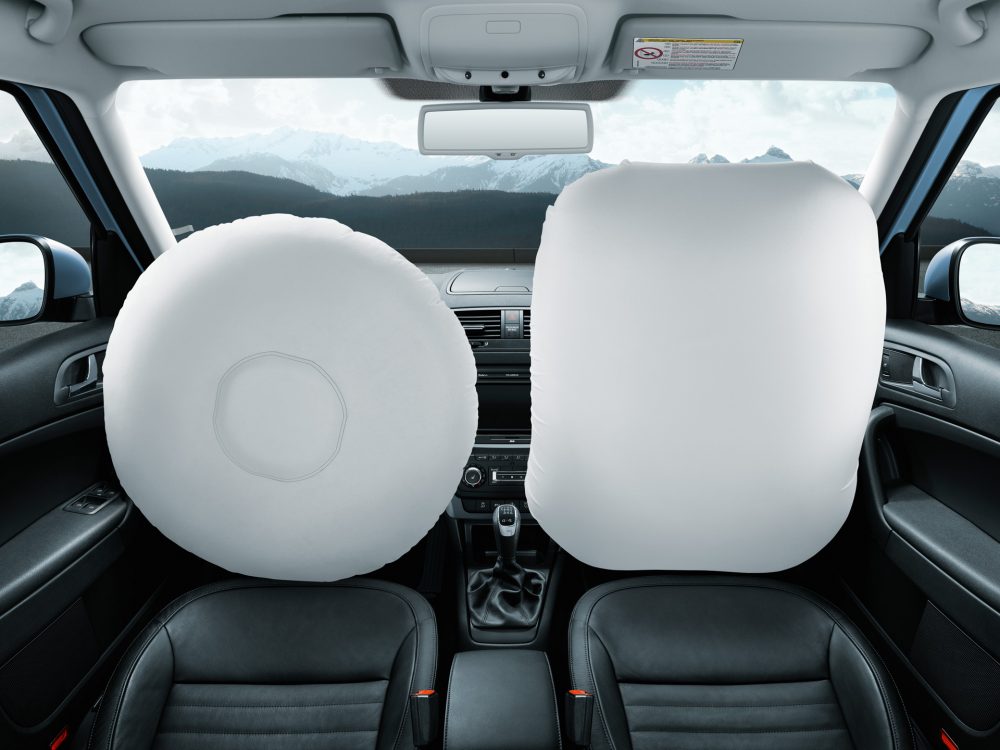
The mechanism of the airbag is designed in such a way that its deployment is governed by the type, angle, and intensity of the collision. Mild frontal collision does not actuate the airbag.
These primitively found their place in a car inside the centre pad of the steering wheel and on the opposite side of the dashboard. Various types of airbags are also embedded in the seats, car’s pillars, seatbelts, lower dash, etc.
The use of airbags in cars has over the years, reduced the number of deaths caused by car accidents tremendously. But what ultimately led to their development in the first place and then widespread usage by all car manufacturers around the world? Let’s find out.
History of the Airbag
What led to the invention of the airbag?
The inception of the airbag dates back to the 1950s when an industrial engineer who had served the US Navy met with a car accident while he was driving with his wife and daughter on board. His name was John W.Hetric. Even though he and his family didn’t get seriously injured in the accident, but still this led Hetrick to realise the need for a device that can ensure the safety of the passengers in case of a collision.

Hence, bringing his Navy engineering experience to work he developed prototypes for a ‘safety cushion assembly’ for vehicles. His design consists of an inflatable bag connected to a tank of compressed air. The bags were located inside the steering wheel, in the middle of the dashboard or near the glove box. The design used a spring setup to sense any impact which actuates the valves in the compressed air tank, releasing the air into the bag and inflating it.
Hetrick got his airbag design filed for a patent with the United States Patent Office in 1952 and received the patent by 18 August 1953.
During almost the same period, a German engineer named Walter Linderer field for a similar patent with the German patent office and received it close to three months after Hetrick received his on 12 November 1953. The Only Difference Between Hetrick and Linderer’s design was that in Linderer’s design the airbags were actuated by bumper impact or by the driver himself.
Must Read: 10 Priorities of an Average Indian Car Buyer | Safety is Not Number One!
Flaws in Hetrick and Linderer’s design
Both of these prototype inflatable occupant restraint systems had issues with inflation. Compressed air induced inflation was not fast enough to release the airbags in time during a collision. Also, springs and bumper impact were not an accurate measure to sense the impact and then decide to deploy the airbag.

Hetrick did pitch his idea to car companies for further development but none seemed to be interested in car safety during that era.
Due to all these factors, Hetrick’s and Linderer’s design were not able to reach the production stage. Still, both of them went down in the history books as the pioneers of the ‘Airbag’ concept.
Breakthrough in the Airbag technology
After further experimentation and learning from Hetrick and Linderer’s designs, auto companies figured that for the inflatable occupant restraint system to work efficiently, it needed an accurate crash sensor and also a chemical catalyst was required to speed up the process of inflation.

In 1967, an American engineer named Allen K. Breed came up with a ‘ball-in-tube’ mechanism for crash detection for the airbags. His system used an electromagnetic sensor and a steel ball which was attached to a tube by a magnet. This, along with the small explosion of sodium azide was to inflate the airbags, instead of using compressed air.
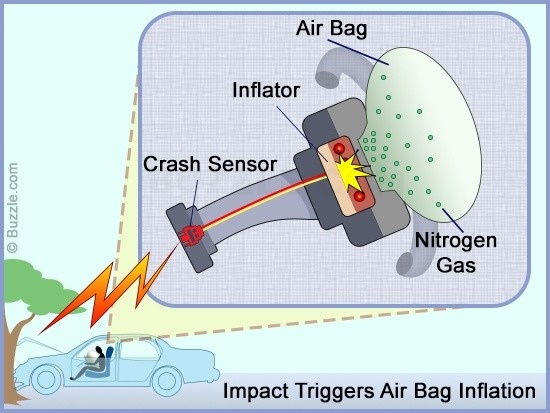
This technology was the first time the automobile industry found the Inflatable occupant restraint system viable for mass fitment and usage and is considered as the beginning of the airbag industry. However, the mass instalment of airbags did not begin until the ’90s.
The first car to have Airbags
Post the revolution in the airbag technology, auto companies decided to experiment with its implementation in their cars. GM and Ford began to install airbags in a few of their test cars during the ’70s. GM decided to come up with airbag-equipped cars for a government fleet purchase in the form of the 1973 Chevy Impala. The particular cars were crash-tested after 20 years of their existence and the results were spectacular. The airbags still worked.
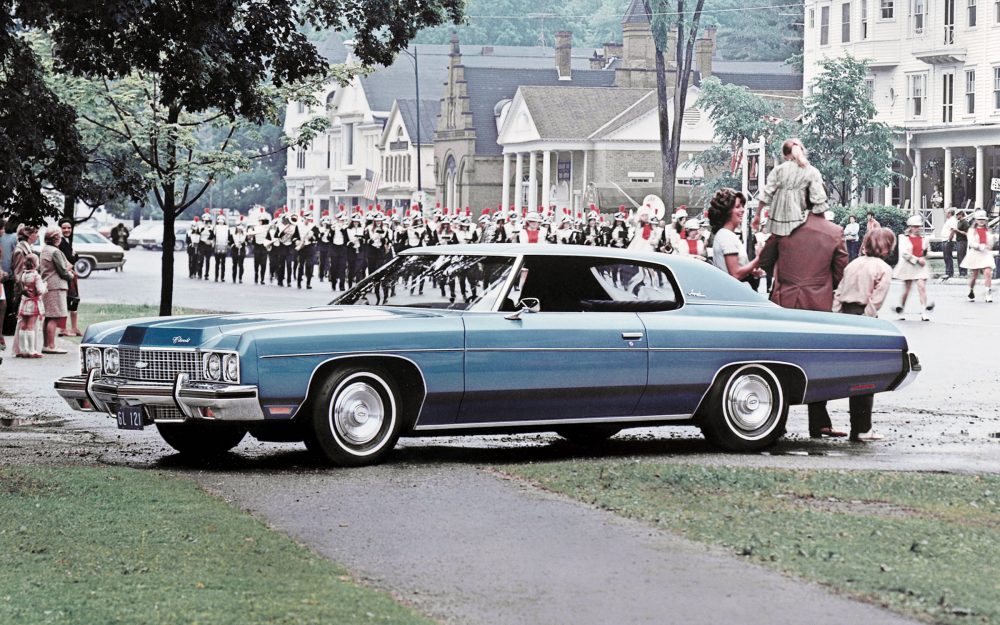
The First car to be domestically available with passenger airbags was GM’s Oldsmobile Toronado and the Airbag system it had was marketed as the ‘Air Cushion Restraint System’ or ACRS.
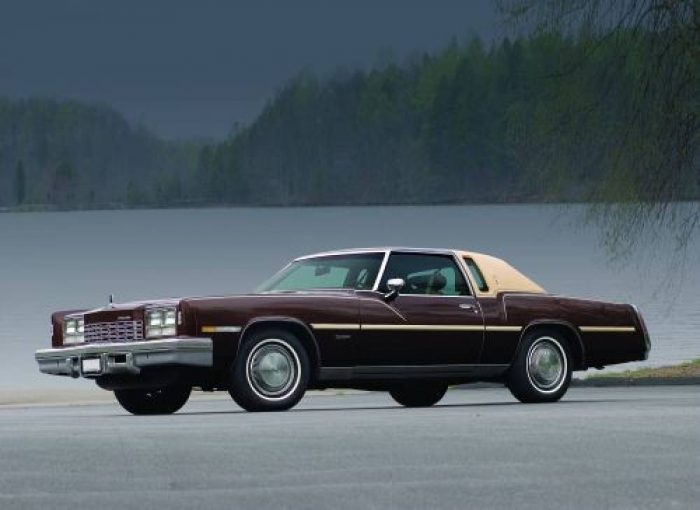
GM removed the ACRS module from the 1977 Oldsmobile Toronado due to low demand and lack of consumer interest in safety features.
Ralph Nader and his battle for car safety
The 1960s and 1970s was an era when Americans were losing more people to car accidents every year than they did in the war. The rate for car accidents caused deaths were 1000 per week back then. So when the airbags came into the scene during a similar era, they seemed like an advanced feature that could ensure the safety of the passengers on the road.
But the widespread use of safety features in cars was hindered by the perception of the automakers, consumers and overall market trends. When we talk about the 60s and the 70s concerning the automobile industry, it was a time when the manufacturers were only bothered about making fast and alluring cars that appealed to the young consumer base. Safety was far away from the debate despite witnessing such tremendous fatalities.

A young lawyer named Ralph Nader in 1965 wrote a book named ‘Unsafe at any speed’ which laid the finger on all major car manufacturers sitting in Detroit (a hub for designing and building cars in America). Ralph accused these automakers of making unsafe cars and how they are ignoring the technology which is out there to make the cars safe.
The accusations and legal trials against the auto manufacturers also laid out how due to an increase in the price of their cars caused the fitment of airbag systems which will, in turn, reduce the sales, influenced the auto industry’s “anti-airbag” behaviour.
The manufacturers also feared that installing safety features in cars could disrupt their image among the public as dangerous vehicles. However, the casualties were speaking for themselves.
Airbags as a substitute for Seatbelt
Nader’s fight against the auto giants came in the spotlight and grabbed political attention. This resulted in the American government to sign legislation in 1966 making seatbelts in cars mandatory(which wasn’t before). But there was one problem, people back in the day simply refused to wear seatbelts, defeating the whole purpose of installing them in the first place.
Hence automakers began to see airbags as an alternative to seatbelts which do not require passenger or driver action. Airbags automatically ensured the safety of the passengers during a collision.
This coincided with the automakers still not in favour of installing airbags. They started to list out the downsides of using airbags in cars, even stating them as dangerous for the passengers. This claim of theirs was backed up by certain instances where cars having airbags as an alternative to seatbelts met with an accident and killed the passengers inside it. Further supporting their claims was the airbags being unsafe for children(for which an algorithm to ensure child safety was introduced in later years) and the use of sodium azide which they claimed to be lethal.
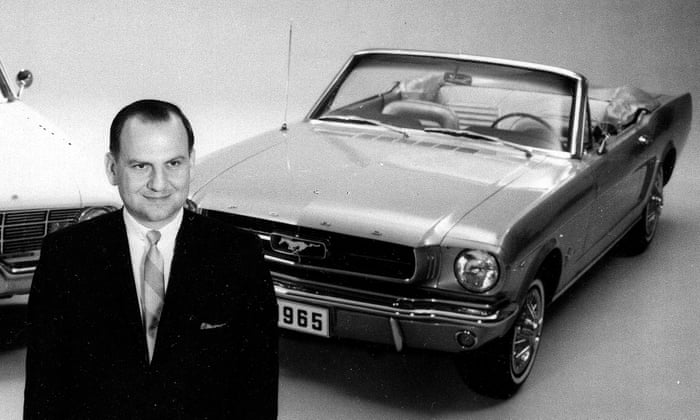
Lee Iacocca, The famous American auto executive ( Chairman of the Chrysler corporation then) deemed airbags as insignificant and highly expensive safety equipment and said that there was no need for such a system when the cars have seatbelts.
In the light of seatbelts being mandated by the government and strong oppression by the manufacturers, the use of airbags as an alternative to seatbelts was forfeited.
Ralph Nader’s fight continued
Ralph Nader’s fight against the auto industry persisted as there were no major amends made as far automobile safety was concerned. Seatbelts weren’t enough to ensure safety and automakers continued to defame the use of airbags, clearly to keep their cars from becoming expensive.
Various administrations that came along this period approved and abandoned the use of airbags, but an ultimate conclusion was yet to come. Nader’s perseverance and the public outrage soon caught up with the administrators and automakers negligence. So finally in 1983, the American administration ruled out that the mandated use of seatbelts and airbags in passenger vehicles is to be reinstated.
A multiple decade struggle by the likes of Ralph Nader finally came into its own and almost all cars sold in America post the late 80s and in the 90s came installed with driver and passenger-side airbags. Side airbags, seatbelts airbags, etc, followed soon after.
Airbags as a supplement to Seatbelts
Soon automakers from around the world other than America like Mercedes, Porsche, Honda, etc, begin to realise the importance of safety equipment in cars and introduced their version of airbag systems in their flagship cars.
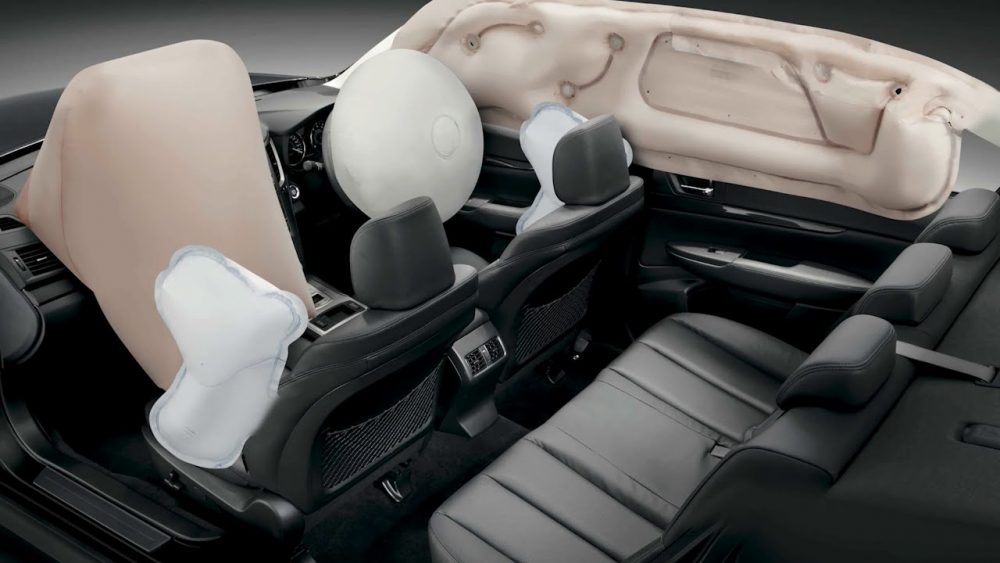
It was during the same period that airbags were started to be perceived as a supplement along with the seatbelts instead of being considered as an alternative to them. So, the airbags came to called a Supplement Restraint System (SRS), also Supplement Inflatable Restraints. Always wondered it says on your steering ‘SRS airbags’? Well, now you know.
Some notable “first-off” cars with airbags

- Porsche 944 Turbo, the first car to have drive and passenger airbags as standard.
Honda Legend, first Japanese car to have airbags.
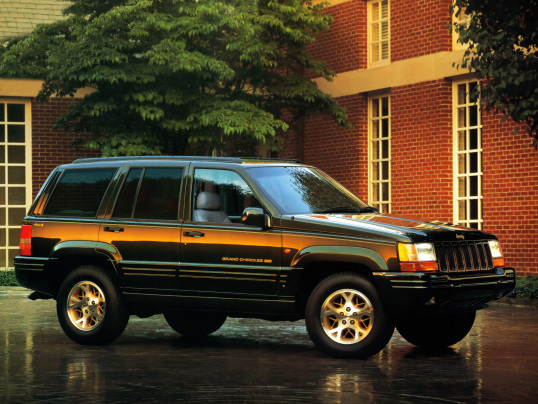
- Jeep Grand Cherokee, first SUV to have driver-side airbags as standard.
Toyota Avensis, the first car with nine airbags to be sold in Europe.
Post-1990s, most cars in the western and European markets came with airbags as at least an option. This meant that car manufacturers along with the consumers were finally putting safety at a greater pedestal than it was ever seen before.
FUN FACT: the first accident between two airbag-equipped cars was recorded on 12 March 1990, When two 1989, Chrysler LeBaron hit each other in a head-on collision causing the driver airbags to deploy in both the cars. Both the drivers suffered only minor injuries despite the collision being highly intense.
Airbags in Indian Cars
The number of casualties caused by road accidents in India annually has always been far greater to western countries. Top Gear during their special feature on India called driving in India as “the most dangerous games on earth”. But just like overseas, it took the Indian authorities a little while to understand the importance of crucial, life-saving safety features for automobiles in India.
During the first decade and a half in India, most of the car manufacturer did not bother to equip their cars with safety features like airbags. Some German Manufacturers and cars above the 15 Lakh cared to have airbags and that too as an option.

There didn’t exist any strict regulations ensuring car manufacturers equip cars with safety features as standard in our country either. this allowed manufacturers to sell their cars with minimum safety equipment.
This landscape begins to take a different shape sometime around 2015 when Manufactures like Toyota, Ford and Volkswagen in India, decided to give safety in cars a greater pedestal even if that meant making their cars less competitive. Toyota even removed the stereos from the lower variants of its cars to accommodate the installation of airbags in the given budget.
Suggested Read: 10 Revolutionary Car Safety Features That Every Car Should Have
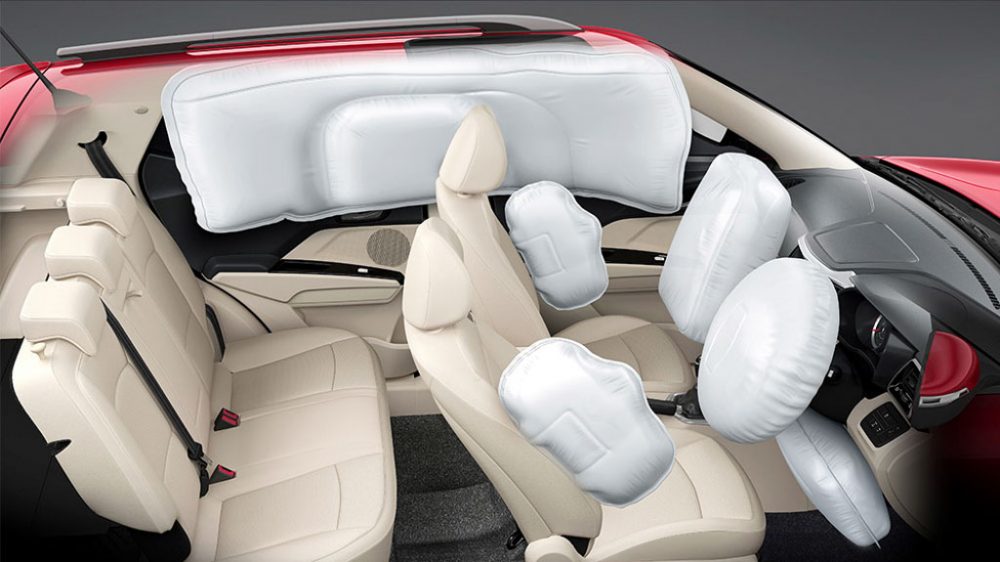
Indian Manufacturers like Tata and Mahindra, who nowadays structure their entire marketing for their cars on them having marvellous safety ratings didn’t come around prioritising safety back them.
Toshihiro Suzuki, president of Suzuki Motor Company, explaining their reason for not installing crucial safety features on their cars in India back then by saying “When I visit India, I see animals on roads or people walking on the highway. Unless these conditions are taken care of, no matter how good airbags or safety devices you add, accidents will not come down.”
Other manufacturers like Honda and Hyundai simply got away by saying that their cars complied with the safety norms of the country which themselves weren’t as strict as they should’ve been during that time.
Safety equipment on cars post the 2019 road safety norms in India
In April 2019 all cars that are to be sold in India must have ABS for all four wheels, reverse parking sensors, driver and passenger seatbelt reminder, speed limit alerts and driver-side airbags as standard safety features.
It was only after this announcement from the government that the Indian manufacturers began to pull up their socks and ensured safety features in their cars across the range. Now, cars like the Tata Nexon, Tata Altroz and Mahindra XUV300 are marketed by their manufacturers as one the safest cars in India.
However, there were plenty of entry-level and outdated cars which didn’t comply with the new safety norms and had to be discontinued by their manufacturers.
On the bright side, the scenario for the new age car buyer is changing gradually and has begun to lean more towards safety in cars being a priority.
Types of Airbags in Cars
Frontal Airbags

Placed inside the steering wheel’s centre pad and passenger-side dashboard. They prevent the passenger from throwing themselves onto the glass or the hard plastics during a frontal collision.
Side Airbags
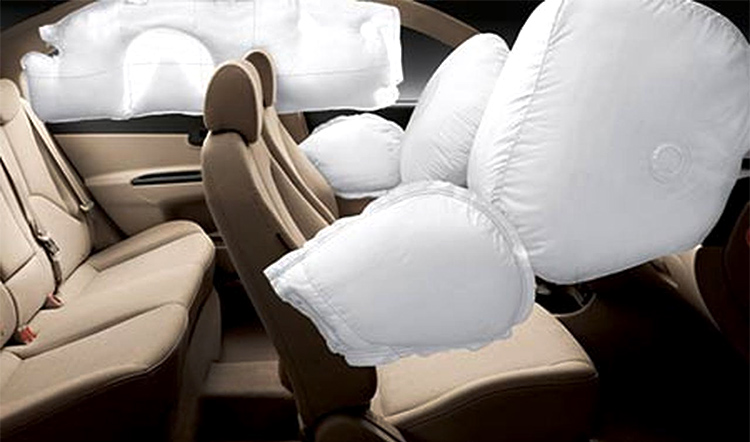
These protect the passengers in the car during a side impact on the car. There are two types of side airbags, side torso and side curtain airbags. The side torso airbag deploys from the seat whereas the side curtain airbags deploy from the car’s pillars. Side curtain airbags have proven to be highly effective in preventing brain injuries to passengers during a side impact.
Knee Airbags
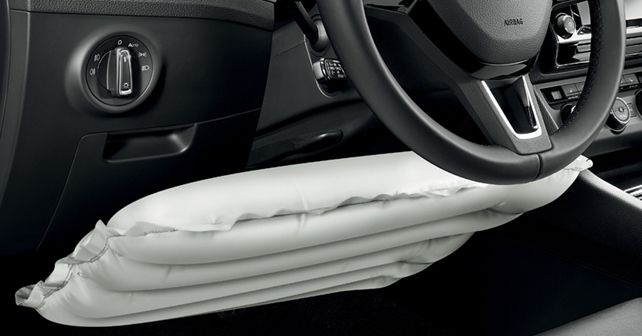
These airbags are mounted beneath the dashboard and deploy to protect the legs of the front passengers during a collision. These were first seen in the 1996 Kia Sportage.
Rear Curtain Airbags
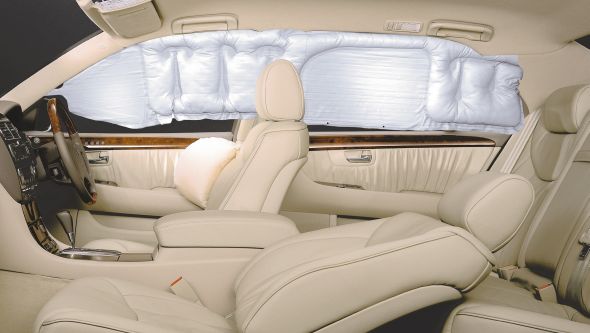
These deploy from the side of the headrest in the rear seats and it helps in protecting rear passengers from a potential head injury during a Collison.
An automobile safety equipment which fought battles to come into existence and influenced almost every safety feature in a modern-day automobile. The airbag’s story is no short of a legend.






